How to talk to your landlord about energy upgrades for leased spaces.

Renting your business space doesn’t mean you’re powerless when it comes to saving energy. In fact, tenants often have more influence than they realize — especially when the conversation focuses on shared benefits, such as cost savings, comfort and long-term value. Whether you’re looking to lower monthly bills, improve working conditions or enhance reliability, energy upgrades can be a win-win for both you and your landlord. Here’s how to approach the conversation with confidence.
Why energy upgrades for leased spaces matter for tenants.
If you’re dealing with rising energy bills, inconsistent temperatures or outdated lighting, you’re not alone. Many tenants in leased commercial spaces face these issues—and feel stuck because they don’t own the building. But energy upgrades can dramatically improve your day-to-day experience. Efficient lighting, smart thermostats, HVAC tune-ups and insulation improvements can all make your space more comfortable and productive, while lowering operating costs at the same time.
And the benefits go beyond the utility bill. Strategic upgrades can reduce maintenance issues, improve system reliability and even enhance employee or customer satisfaction. The key is making sure your landlord sees the value, too. Here are some steps you can take to start the conversation.
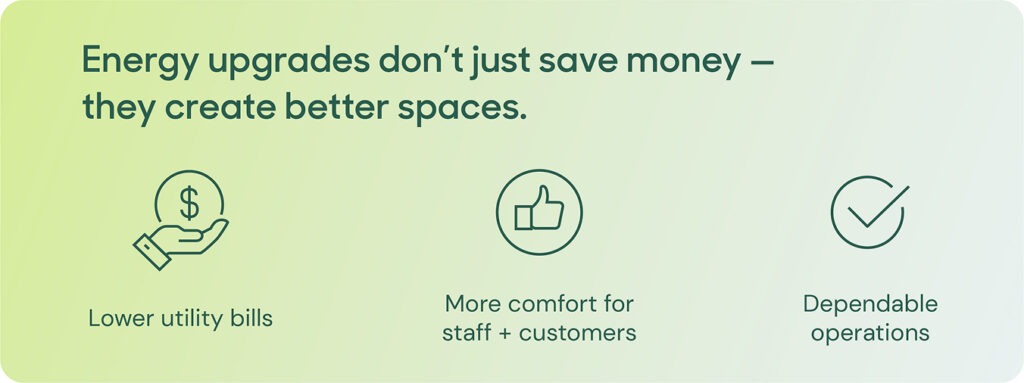
1. Understand potential roadblocks.
Tenant-landlord dynamics may impact decisions about building improvements. You may not have full authority to make changes to systems like lighting or HVAC, and your landlord may not feel motivated to invest in upgrades that primarily lower your bills — a common issue known as a split-incentive problem. You reap the savings, and they pay the upfront cost.
Short-term leases can be another barrier. Landlords might worry they won’t see a return on investment if tenants relocate before the payback period ends. But these objections aren’t deal-breakers. They’re just part of the conversation. Being prepared can help you address them head-on.
2. Identify your opportunities.
Before starting the conversation, take the time to identify specific upgrades or improvements that could make a significant impact in your space. Start with areas that offer high energy savings and fast paybacks, like:
- LED lighting uses up to 75% less energy compared to incandescent lighting.
- Smart thermostats to automate temperature control based on occupancy.
- HVAC tune-ups to improve indoor air quality, efficiency and extend system life.
- Weatherization and insulation to help stabilize indoor temperatures.
Even better: gather quick data on potential cost savings using tools like TVA EnergyRight’s incentive calculator. You can also note any performance issues like hot or cold spots, flickering lights, or equipment noise that support your case for improvements.

Sources: Energy.gov, EnergyRight.com; nrel.gov
3. Turn talk into savings.
The best time to talk about energy upgrades is before there’s a problem—not after the HVAC system fails on a 90-degree day. Bring up the topic during a lease renewal, a property walkthrough or even a casual check-in. Come prepared with:
- A short list of potential upgrades.
- Examples from similar properties or business case studies.
- Information on available TVA EnergyRight® incentives.
Sharing success stories or information on incentives from TVA EnergyRight can make your pitch more concrete and less abstract.

Sources: ApartmentTherapy.com; EnergyRight.com; Score.org
4. Frame the conversation as a win-win.
Once you’ve identified your priorities, focus on how these upgrades can benefit both you and your landlord. The goal is to reframe the request as a shared investment in the property’s long-term value.
For you as a tenant, the value is clear: lower energy bills, increased comfort and more reliable operations. For your landlord, the upgrades can translate into higher building value, lower vacancy rates and a more marketable property. In today’s competitive rental market, energy-efficient buildings are becoming increasingly attractive to prospective tenants—especially those seeking modern, sustainable spaces.
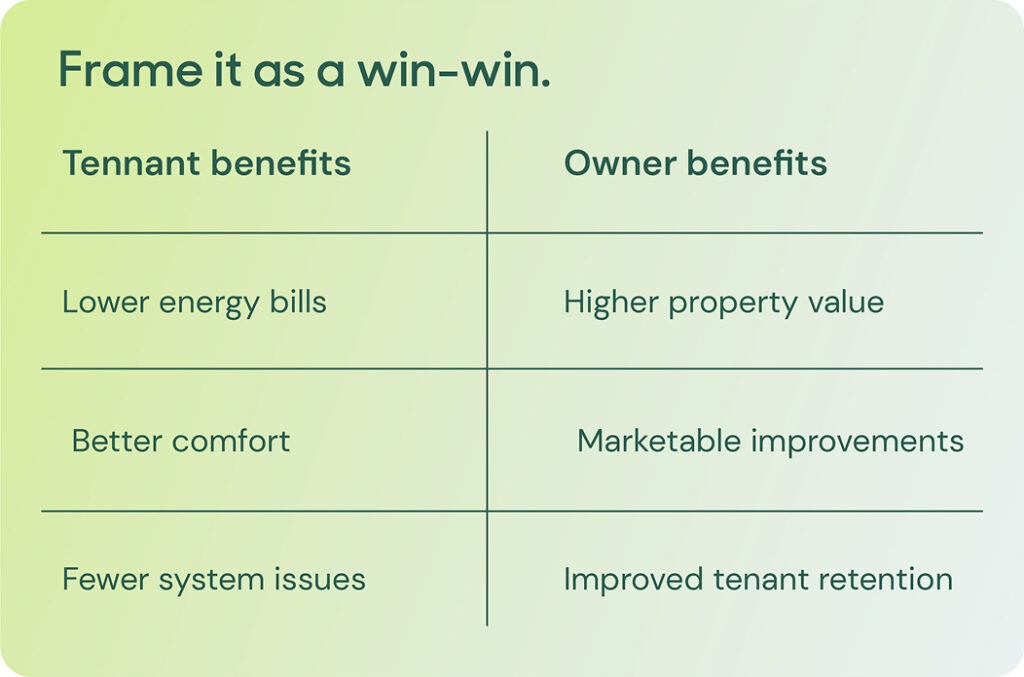
Source: EnergyStar.gov
5. Offer to partner in the process.
You don’t have to make the request and hope for the best — you can offer to be part of the solution. If you’re proposing larger upgrades, suggest starting small with a pilot project like retrofitting just one area with LED lighting. You can also propose a cost-sharing model or help by researching contractors, gathering quotes or completing incentive paperwork. This kind of proactive partnership can go a long way in showing your landlord that you’re serious and solution-oriented.
Another way to strengthen the landlord-tenant partnership around upgrades is through an energy-aligned lease. Instead of leaving energy use and costs to chance, these agreements build energy efficiency language directly into the lease itself. For example, clauses can allow landlords to recover a portion of capital expenses for upgrades through operating costs while ensuring tenants share in the savings.
According to the Institute for Market Transformation, energy-aligned leases can reduce utility bills by up to $0.51 per square foot and cut office building energy use by as much as 22%. In practice, this turns the split-incentive problem into a shared-investment model — landlords benefit from higher property value and improved net operating income. At the same time, tenants gain lower bills, better comfort, and more reliable systems.

Take the next step.
If your landlord is open to the idea, recommend setting up a walkthrough with your local power company or another energy expert. TVA EnergyRight can provide tools, resources and support to help identify energy upgrades for leased spaces and the available incentives.
Remember, you don’t have to navigate this alone. Even a single conversation can lead to improvements that benefit everyone who uses the space.
A win-win worth talking about.
Energy upgrades don’t just save money — they create better places to do business. And while you may not own the building, you can help shape its future. So, go ahead. Start the conversation with your landlord, focus on the mutual benefits, and come prepared with information and ideas.
Need help? Connect with a TVA Energy Expert to explore your options and get expert support.
The Truth About the ROI of Energy Efficiency for Small Business Owners
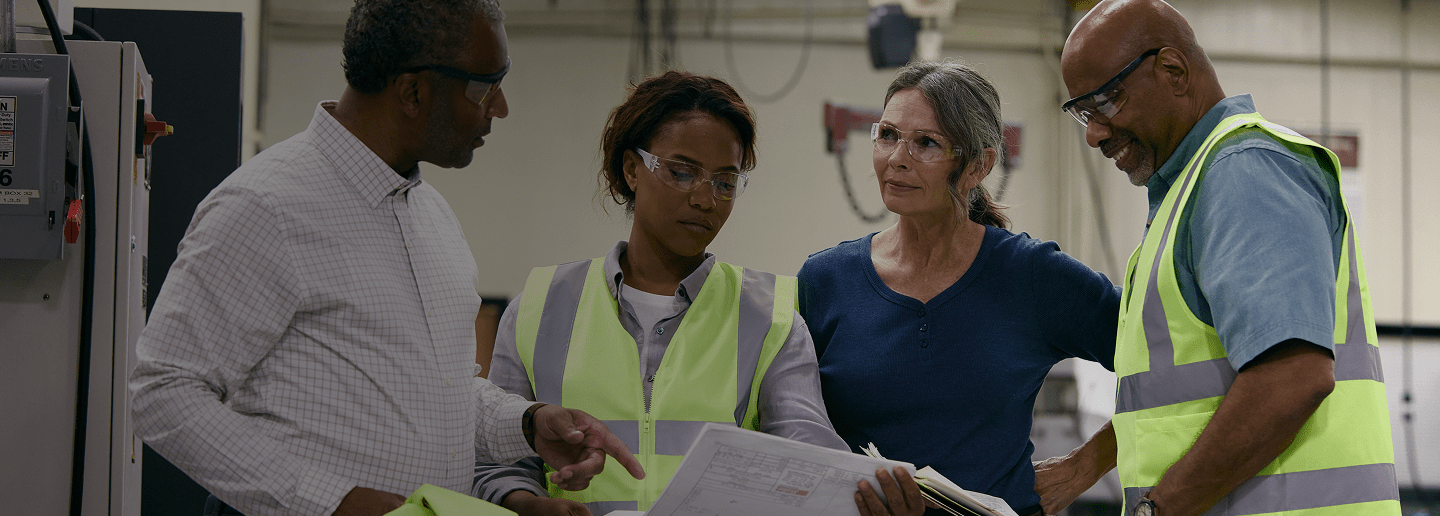
Running a small business means watching every dollar. Rent, payroll, inventory and marketing — it all adds up fast. But there’s one line item that’s often overlooked: energy costs. Utility bills can eat into margins, and unlike other expenses, they don’t go away on their own. The good news? Energy efficiency upgrades offer one of the most reliable returns on investment (ROI) available to small business owners.
Why the ROI of energy efficiency matters for small businesses.
Energy is often a top-three expense for small businesses, behind only labor and rent. That means efficiency isn’t just a sustainable choice — it’s a smart financial strategy. Beyond savings, efficiency upgrades enhance comfort, improve the customer experience and even boost employee productivity.
The case for efficiency.
The ROI of energy efficiency is measurable. According to ENERGY STAR, small businesses can cut utility costs by up to 30% with upgrades that quickly pay for themselves.
- Lower monthly bills: Upgrading equipment to more efficient models reduces energy bills. Just swapping outdated lighting for LEDs alone can reduce electricity use by up to 75%.
- Incentives and other energy solutions: Make your equipment upgrades more affordable with incentives from your local power company and TVA EnergyRight®, which can help reduce project costs and the payback period.
- Long-term value: Once installed, upgrades like HVAC and Refrigeration continue saving money year after year.

Sources: energy.gov, energystar.gov, EnergyRight.com
Small investment = big benefits.
The value of efficiency goes beyond numbers on a utility bill. A well-lit, inviting space makes a difference for everyone who walks through your doors.
Stronger customer experience: Bright, well-lit spaces encourage shoppers to stay longer — and spend more.
Better working conditions: Improved HVAC and lighting create a comfortable environment for businesses and other organizations, like schools.
Improved employee satisfaction: Studies show comfortable workplaces and better lighting boost productivity and reduce turnover.

Sources: epa.gov; hrfuture.net; pecnw.com
Real-world ROI: Ironhorn Enterprises
Energy efficiency isn’t just about trimming bills—it can help seal business deals, too. Take Ironhorn Enterprises, a commercial real estate firm specializing in industrial and warehouse properties.
When a new tenant was interested in leasing an Oak Ridge, Tennessee, warehouse, the outdated 1,000-watt metal halide lighting threatened to derail the deal. Powering the space would have been too costly for the tenant to justify.
The solution: Ironhorn partnered with the Oak Ridge Electric Department and TVA EnergyRight® to upgrade the facility with 110 energy-efficient 300-watt LED high-bay fixtures.
The results:
- 317,638 kWh annual energy savings
- $30,914 in annual energy cost savings
- $28,205 incentive from TVA EnergyRight
- Simple payback: <5 months
Beyond the impressive numbers, the upgrade helped Ironhorn secure the tenant, modernize its property and enhance long-term value.
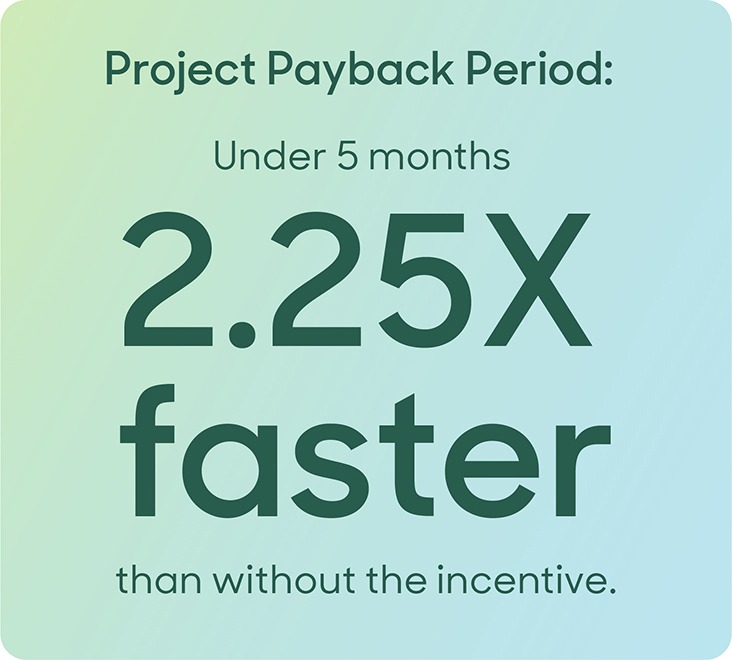
Beyond cost savings: building resilience and brand value.
Today’s customers expect businesses to operate sustainably. Using the ROI of energy efficiency metric is a way to show that you care about your community while strengthening your bottom line. It also makes your business more resilient—less vulnerable to rising energy prices or unexpected system breakdowns. Positioning your business as efficient and sustainable can become a competitive edge that attracts both customers and talent.
How to get started.
Getting started doesn’t have to be complicated.
- Save up to $375 in annual energy costs with a free Smart Energy Starter Kit from TVA Energy Right and your local power company.
- Explore TVA’s incentives and other programs to get upgrades with short payback periods.
- Work with a TVA Energy Expert to identify the best opportunities for your space.
For small business owners, energy efficiency is more than a buzzword — it’s a proven investment. Lower bills, improved comfort, happier employees, and a stronger brand all add up to measurable ROI and long-term success.
Take the first step today. Explore TVA incentives, request your Smart Energy Starter Kit and start saving.

Frequently Asked Questions
Q: What is the ROI of energy efficiency for small businesses?
The ROI varies by project, but many small businesses see payback in just a few years — or even months. For example, lighting retrofits with LED fixtures can cut electricity costs by up to 75% and often pay for themselves in under two years.
Q: What are the best energy efficiency upgrades for fast payback?
High-impact, low-cost projects, like LED lighting updates, HVAC upgrades and smart thermostats, often deliver the quickest payback. These upgrades lower monthly utility bills and improve comfort for employees and customers.
Q: Can energy efficiency improve employee productivity and customer experience?
Yes. Better lighting, consistent indoor temperatures and improved air quality create a more welcoming space. Employees tend to be more comfortable and productive, while customers enjoy spending more time in your business.
Q: How can small businesses in the region get started with energy efficiency?
TVA EnergyRight offers a complimentary Smart Energy Starter Kit to help small and mid-size businesses take the first steps to cut energy costs. If you are ready to replace equipment like LED lighting, HVAC or Refrigeration, our incentives make the investment more affordable, and a TVA Energy Expert can guide you through options that deliver the most impact for your business.
5 smart strategies to improve commercial energy efficiency.

Proven strategies for building performance, budget control and resilience in commercial environments.
Commercial energy efficiency is often framed as a daunting, high-stakes challenge. Rest assured, your energy goals are attainable. The key is to start with what you can control, lean into collaboration and let quick wins fuel your long-term strategy.
In a recent panel discussion hosted by TVA EnergyRight, energy leaders offered an objective and actionable perspective on commercial energy efficiency. Featuring voices from General Mills, Metro Nashville, Middle Tennessee Electric (MTE), and Nashville Electric Service (NES), the discussion offered practical steps organizations of all sizes in both the private and public sectors can take. Here are five standout strategies — rooted in both experience and impact.
1. Prioritize utility and government collaboration.
Work with your local power company and city team, not around them.
When working in sectors such as large industrial facilities, municipalities, hospitals or universities, efficiency goals are often developed in isolation — only to run into roadblocks related to permitting, infrastructure or communication. But when utilities and city agencies are brought in early, those barriers can become opportunities.
Public-private partnerships can accelerate impact, and transparent conversations can help clarify shared goals and smooth the path forward. For example, public-sector entities like Metro Nashville are aligning energy planning efforts across more than a dozen departments by coordinating data and infrastructure planning — proving the value of early relationship-building for shared success.
“We’re often working across a very diverse set of departments, and we’re trying to create a centralized way of thinking about energy use and performance,” explains Kendra Abkowitz, Senior Director of Sustainability and Resilience, Office of Mayor Freddie O’Connell, Metro Nashville.

Utility-customer collaboration is one of the strongest predictors of success in commercial energy efficiency programs, particularly when supported by effective data sharing and technical guidance. According to Fulcrum, partnerships that unite the strengths of different sectors around shared energy goals tend to deliver better outcomes. That’s why electric utilities often team up with local governments, technology providers and community organizations to expand energy capacity and embed smarter energy management practices across operations.
Sources: fulcrumapp.com; nashville.gov
2. Focus on community partnerships.
Broaden your network to broaden your impact.
Think beyond facility systems and consider where your community is already laying the groundwork for success. Partnering with local energy providers or city agencies can unlock funding, enhance resilience and help large energy users — like industrial facilities, municipalities, hospitals and commercial campuses — better serve their operations and communities. Tapping into these partnerships can unlock access to tax credits, grants and TVA programs. More importantly, it’s an opportunity to build trust and deliver a broader impact.
Public sector partnership in action: Powering Metro Nashville’s efficiency goals.
One standout example of partnership in action is the 160 megawatt (MW) solar project developed through TVA’s Flexibility program. This unique initiative allows participating local power companies to generate up to 5% of their energy load through locally sourced, cleaner energy.
In this case, Nashville Electric Service (NES) teamed up with Metro Nashville and Silicon Ranch to develop a utility-scale solar array that directly supports Metro’s ambitious sustainability goals — providing clean, renewable energy to power key municipal facilities, reduce carbon emissions and stabilize long-term energy costs.
This collaboration didn’t just result in new solar infrastructure. It demonstrated what’s possible when utilities and public sector organizations align their goals, share the planning process and leverage the financial and technical support available through TVA’s regional programs.
Industrial collaboration: General Mills’ waste-to-energy solution.
Private-sector businesses like General Mills are also embracing collaborative, circular solutions by working hand-in-hand with local utilities and city leaders. At their Murfreesboro, Tennessee, facility — home to the production of all Pillsbury Toaster Strudels and about half the nation’s Yoplait yogurt — they partnered with Middle Tennessee Electric (MTE) and leveraged federal green energy incentives to turn yogurt waste into usable power.
Together, they leveraged federal rebates to turn yogurt waste into energy, installing a 1.6 MW generator powered by methane from their on-site anaerobic digester. The project not only reduced emissions and operational costs but also improved site resilience, all of which was made possible by proactive support from the local power company.
Daren Kaiser, Global Energy Strategy Leader for General Mills, says, “We got 40% of that cost covered by a federal rebate, but the real win was Middle Tennessee Electric’s willingness to partner with us. MTE was with us every step of the way. They probably worked harder than our contractors to make sure it came together. That kind of partnership makes innovation possible.”
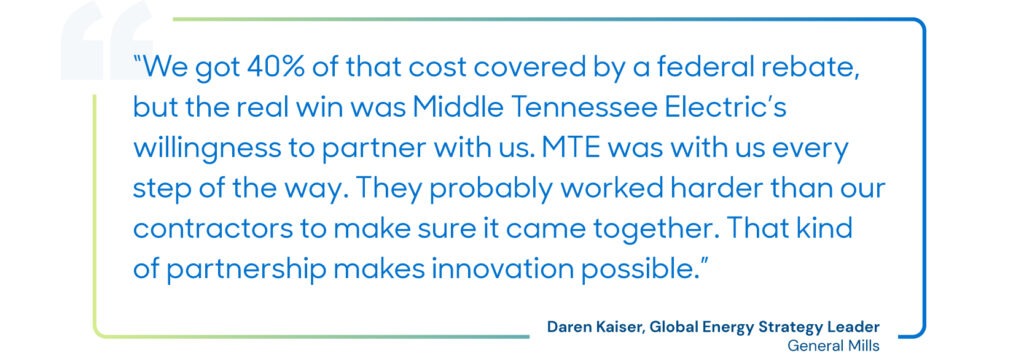
This type of solution — where waste becomes fuel and utilities help enable, rather than hinder, the process — demonstrates how circular systems can thrive through a shared vision and effective execution.
Sources: siliconranch.org; nashville.gov; cen.acs.org
3. Engage communities and employees.
Efficiency starts with people, not just systems.
Many organizations focus on systems, sensors and technology while overlooking the people who use them. However, both the City of Nashville and corporate leaders on the panel emphasized the importance of engagement in building trust and long-term buy-in.
Metro Nashville gives public tours of solar installations and dashboards to make performance visible and celebrate wins. Internally, companies like General Mills are establishing “green teams” across departments and empowering employees to participate in efficiency planning. And in large systems like hospitals, facility directors and energy teams can use similar tactics — engaging both staff and the surrounding community through energy awareness campaigns as well as training and incentives for employees to identify efficiency opportunities.
Innovative energy projects can sometimes spark internal pushback, especially when other departments are facing budget constraints. Employees may question why specific initiatives move forward while their priorities are put on hold. That’s why transparency and communication are key.
Brent Baker, EVP and Chief Operations and Innovation Officer for Nashville Electric Service, notes, “When budgets are tight, people notice where the money goes. Even if it’s a different bucket, you still have to explain why one project moves forward over another. That’s real.”

Don’t underestimate the power of storytelling. Sharing before-and-after data or involving staff in pilot projects can drive broader adoption and boost your bottom line.
When it comes to employee engagement, nearly 74% of employees report that their jobs are more fulfilling when they have the opportunity to positively impact social and environmental issues. And companies with a highly engaged workforce are 21% more profitable and 17% more productive.
Whether it’s showcasing real-time dashboards, giving public tours or celebrating internal wins, making energy progress visible helps build trust and enthusiasm. The more employees and community members understand the impact of efficiency efforts, the more likely they are to support and sustain them.
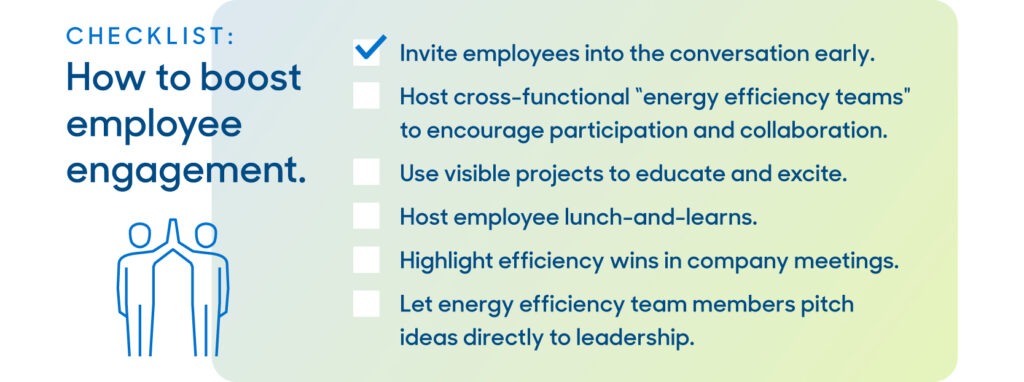
Sources: conecommunicationsco.com; gallup.com
4. Start with quick wins and build momentum.
Progress beats perfection.
Instead of getting stuck on your biggest energy challenge, start with what’s doable. Whether it’s lighting upgrades, HVAC optimization or low-barrier process improvements, small steps build trust, deliver results and recruit allies.
Kendra Abkowitz recommends identifying low-conflict opportunities — even if they don’t move the emissions needle right away.
She says, “Find your quick wins, so you can build momentum, but work where you have that runway and not too many barriers, even if it doesn’t always seem like the most impactful area. This can help gain allies for the work who can be helpful as you move into more challenging areas.”

These smaller successes are more than morale boosters — they can lay the groundwork for long-term change. According to the U.S. Department of Energy, low-cost or no-cost improvements, like LED lighting or thermostat adjustments, can reduce energy use by up to 20% in commercial buildings. That’s not just savings — it’s proof that efficiency works.
Cross-functional teams can accelerate this process. Brent Baker of NES recommends pairing skeptics with champions. “The lightbulb moments happen when cross-functional teams come together — when someone who’s not sure gets to see the benefit firsthand,” says Baker.
Source: energy.gov
5. Scale smart: invest for resilience and carbon reduction.
Pair your momentum with long-term investment.
Once you’ve captured early wins and built internal support, the next step is to take on transformational projects that deliver lasting cost savings, operational resilience and regulatory compliance — ideally with strong utility partnerships and a clear strategy for financing and implementation.
These investments may include:
- On-site solar and battery storage.
- Waste-to-energy systems such as anaerobic digesters or combined heat and power (CHP) units.
- Fleet electrification or replacing fossil-fueled equipment with electric alternatives.
Energy-intensive facilities, including manufacturing plants, universities and hospitals, can benefit from these investments, not only to reduce emissions but also to ensure energy reliability for critical systems. For example, some healthcare facilities have already implemented combined heat and power (CHP) units to enhance energy efficiency while providing a resilient backup power source for operating rooms, ICUs and labs in the event of an outage.
While the up-front costs for these technologies can be higher, aligning with utility programs and incentive structures can dramatically improve ROI. TVA’s EnergyRight incentives, for example, have helped companies across the region accelerate their transition while staying competitive. Early coordination with your local power company can also help smooth interconnections, identify potential grid limitations and ensure operational reliability.
Investing in Carbon-Free Technologies.
At General Mills, a combination of clean energy strategies has helped them reach net-zero emissions for Scope 2 electricity use, thanks to a mix of RECs and renewable power purchase agreements. To reduce Scope 1 emissions — which are typically harder to address — they’ve implemented waste-to-energy systems at several sites, including a 1.6 MW CHP unit fueled by methane from yogurt waste at their Murfreesboro plant.

Think of Scope 1 as “on-site” emissions and Scope 2 as “purchased energy” emissions.
Why it matters.
According to the International Energy Agency, clean electricity and electrification will account for more than 50% of global CO₂ reductions needed to reach net zero by 2050. Businesses that adopt low-carbon technologies now are better positioned to address regulatory shifts, meet customer expectations and ensure future energy resilience.
It’s not just about checking a sustainability box. It’s about improving reliability, controlling costs and preparing for long-term success.
Source: iea.org
The bottom line? Balance.
From morale and momentum to grid resilience to cost savings to decarbonization, the path forward isn’t one-size-fits-all, but it is a walkable one. As panelist Robert White of MTE explained, “This next generation of customers, they’re pushing, and they don’t want to hear excuses. They want to hear commitments — at the same time, we’re trying to find that balance between reliability and affordability. We want to be part of the solution.”

Meeting energy goals in both private and public commercial sectors requires balancing performance, cost and care delivery — without compromising on reliability. As TVA’s VP, Environment and Stewardship, Michael McCall explains, “There’s no free lunch. Every energy source has trade-offs. The real goal is to stay committed, work together and keep showing up.”
Ready to take the next step?
Connect with your local power company and a TVA Energy Expert to explore energy efficiency options tailored for your business or facility.
Power moves: How innovative facilities turn their utility into a strategic growth partner.
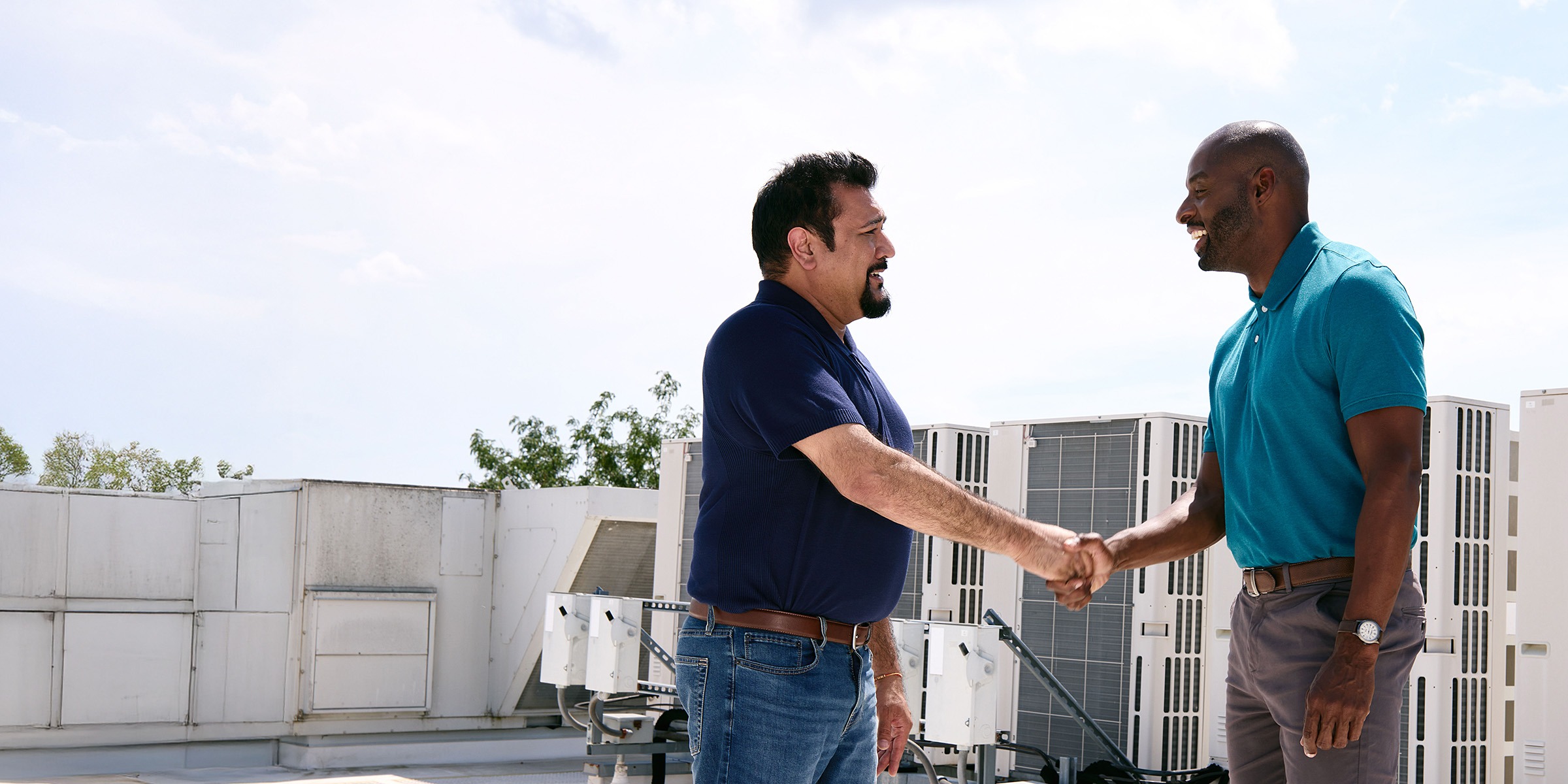
Stop thinking of your local power company as just another bill to pay. Start thinking of them as one of your competitive advantages.
Rethink what your utility can do for you.
In today’s high-stakes operational environment, energy is more than a line item — it’s a strategic lever. But most facilities treat their local power company (LPC) as a background vendor.
What if, instead, you treated them like a growth partner?
Stop overlooking your most powerful business ally. From infrastructure planning to incentive stacking, your LPC can help you cut costs, boost performance and future-proof your operations. And yes — sustainability often comes baked in.
Step 1: Bring them in early, before growth becomes a challenge.
If you’re scaling, shifting or modernizing operations, your energy needs are changing — fast.
The smartest move? Loop in your LPC before you break ground or expand your process lines.
LPCs like Middle Tennessee Electric (MTE) have helped major industrials like General Mills avoid costly redesigns and power bottlenecks by modeling future load growth, flagging infrastructure gaps and helping shape more innovative expansion plans from the start.
Robert White, VP of Community Relations & Member Services for MTE, explains, “We helped General Mills integrate a 1.6 MW anaerobic digester. We were at the table from the beginning, and that helped them avoid obstacles later.”
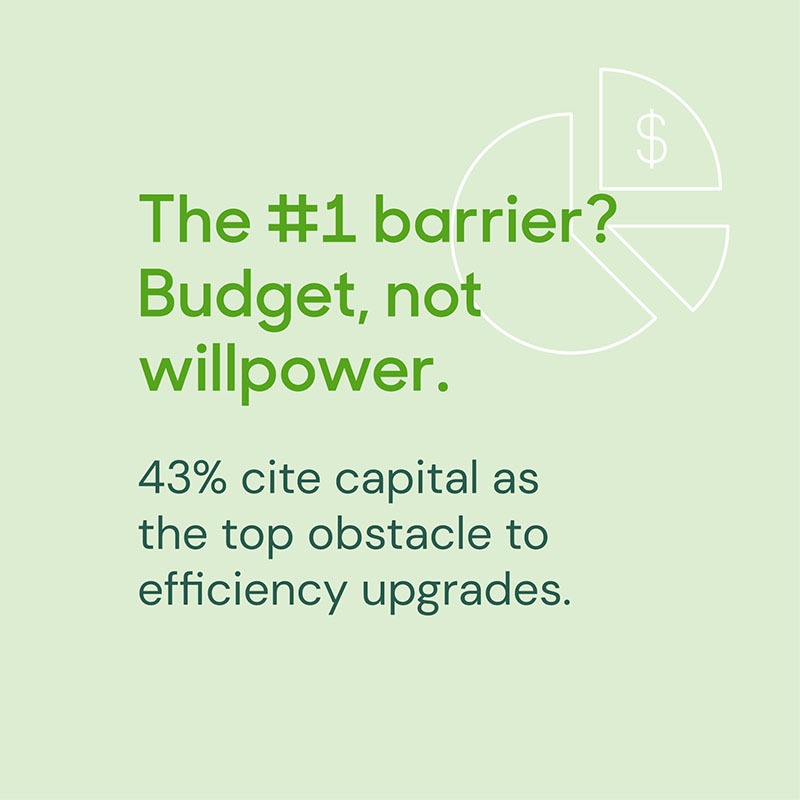
Source: deloitte.com; energy.gov
Step 2: Tap into incentives you didn’t know you had.
Efficiency upgrades can deliver fast ROI, and in the Tennessee Valley Region, LPCs in partnership with TVA EnergyRight are willing to help you pay for them. The trouble is, too many businesses leave those dollars on the table.
From lighting and HVAC to refrigeration and advanced building controls, your LPC may offer:
- Rebates that reduce capital expenditures.
- Demand response payments to reduce peak load costs.
- Shared-risk pilot programs for new technologies.
Vanderbilt University Medical Center, for example, received a $243,000 TVA EnergyRight incentive through Nashville Electric Service (NES), which is now delivering $200,000+ in annual savings.
Source: EnergyRight.com
Step 3: Use utility data to benchmark, optimize and scale.
Your LPC has visibility across sectors, regions, and use profiles. That means they know what “good” looks like — and where your facility may be falling short.
“We can bring benchmarking data to the table. That’s the power of working with an LPC that knows the territory,” says Brent Baker, EVP and Chief Operations and Innovation Officer, NES.
By sharing load data and operational goals, you can uncover:
- Inefficiencies you didn’t know existed.
- Time-of-use strategies to reduce spend.
- Long-term energy models that align with your growth targets.
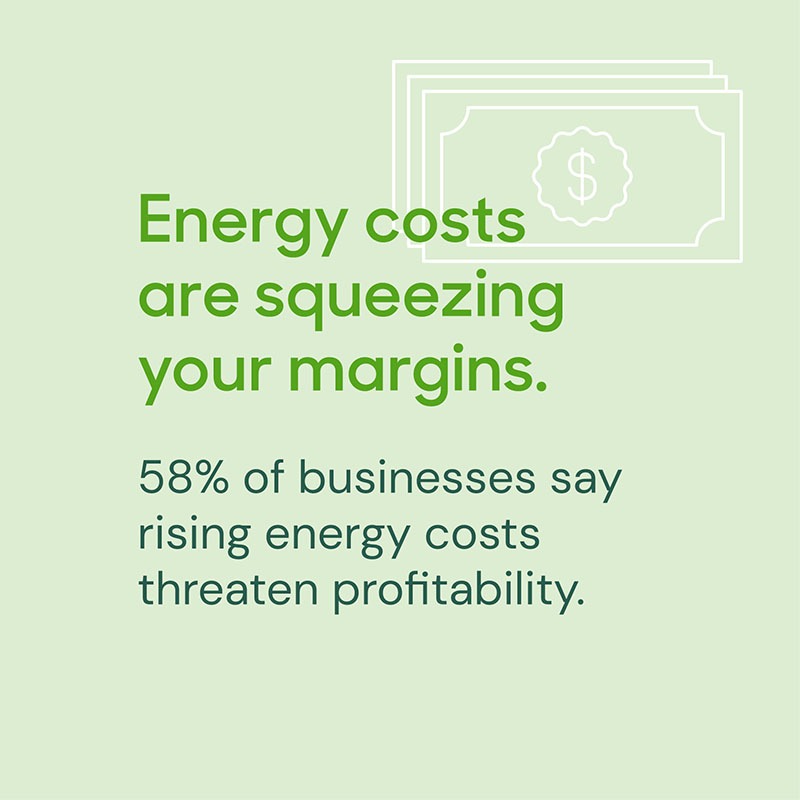
Source: energy.gov
Step 4: Reduce the risk for big ideas with a technical ally.
Innovation always carries risk — but your LPC can help you sell it to your team and manage it.
Whether you’re exploring on-site generation, EV fleet planning or battery storage, utilities can support you with:
- Interconnection guidance.
- Reliability modeling.
- Regulatory navigation and incentive layering.
General Mills has achieved net-zero Scope 2 emissions globally. With help from MTE, they integrated a 1.6 MW generator powered by yogurt waste — an anaerobic digester that cut emissions and costs while increasing energy independence.
General Mills achieved net-zero Scope 2 emissions globally.
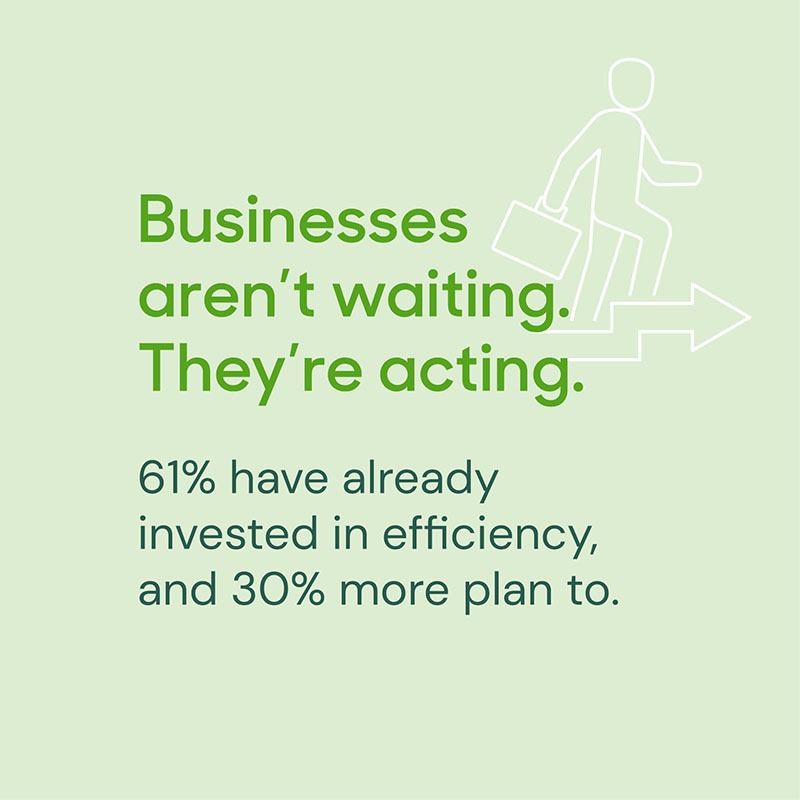
Source: energy.gov
Step 5: Make energy efficiency your competitive advantage.
Sustainability might sound like a buzzword — but in practice, it’s often the byproduct of smart, forward-thinking business decisions. And energy efficiency? It’s not just about cutting costs. It’s about building resilience, boosting productivity, and unlocking long-term value.
When you partner with your LPC to optimize systems or reduce reliance on fossil fuels, you’re not just reducing overhead, you’re:
- Strengthening your operational reliability.
- Improving safety and performance metrics.
- Reinforcing your long-term competitiveness.
Whether you run a manufacturing plant or a university campus, every efficiency upgrade is an investment in your facility’s ability to scale, adapt and thrive.
According to the EEM 2024 Energy Efficiency Investment Survey, 24% of annual operating costs for businesses go to energy.
Source: EnergyRight.com; energyefficiencymovement.com
Final thought: Loop them in early. Lean on them often.
Before you call your engineer, contractor or architect, call your local power company.
They’re already invested in your success. And when you treat them like a strategic partner, not just a service provider, the benefits ripple across your operations — from budget to resilience to bottom line.
